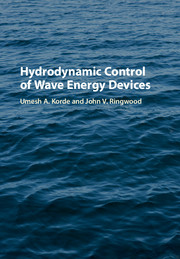Book contents
- Frontmatter
- Contents
- Preface
- Acknowledgments
- Part I Introduction
- Part II The Basics
- Part III The Hydrodynamics
- Part IV Velocity Control Using a Hydrodynamic Model
- Part V Control by Optimizing a Performance Index
- Part VI Toward Overall WEC System Hydrodynamic Optimization
- Part VII In Closing
- 15 Conclusion
- References
- Index
15 - Conclusion
from Part VII - In Closing
Published online by Cambridge University Press: 05 September 2016
- Frontmatter
- Contents
- Preface
- Acknowledgments
- Part I Introduction
- Part II The Basics
- Part III The Hydrodynamics
- Part IV Velocity Control Using a Hydrodynamic Model
- Part V Control by Optimizing a Performance Index
- Part VI Toward Overall WEC System Hydrodynamic Optimization
- Part VII In Closing
- 15 Conclusion
- References
- Index
Summary
We have often heard that writing a book is one of the best learning experiences an author will have. We have certainly found this to be true in our case. It has also become clear to us that there is still much we do not know. This entire book is based on linear theory. We assume small-amplitude waves and small-amplitude oscillations. We have therefore been able to work with linear differential equations and first-order convolutions throughout. We have also been able to use linear superposition of displacements and forces, just as we have been able to apply forward and inverse Fourier transformations when required. We have been able to invoke linear-state space approximations and matrix algebra results wherever they seemed appropriate.
While linear theory has convincingly demonstrated its success in capturing the essence of phenomena that would be difficult to comprehend otherwise, as the field moves forward, there will come a time when our questions become more sophisticated and require answers that are more specific and more intricate. We are witnessing such progress already. Indeed, just the last 2–3 years have seen a rapidly growing interest in nonlinear modeling and nonlinear control of wave energy devices.
Most nonlinear modeling approaches that are somewhat general in scope tend to build on the linear solutions. Many such approaches use a perturbation type technique (e.g., [60]), that “expands” the actual solution with respect to a perturbation parameter (typically small). Alternatively, one could use multiple-scale expansion approaches [8] to provide similar results. Solutions are typically obtained to increasing orders of accuracy, each subsequent-order solution building on the previous-order solutions. Thus, solutions that are accurate to second order contain functions of the first-order solution, while solutions accurate to third order will contain both second- and first-order solutions. First-order solutions are just our linear solutions, however. Thus, the linear theory-based approaches discussed in this book can be utilized as the basic building blocks for the higher-order solutions required for nonlinear problems. Therefore, a good grasp of the linear theory-based approaches of this book may be essential for anyone hoping to sift through and quantify the different effects of multiple nonlinearities.
- Type
- Chapter
- Information
- Hydrodynamic Control of Wave Energy Devices , pp. 347 - 350Publisher: Cambridge University PressPrint publication year: 2016



